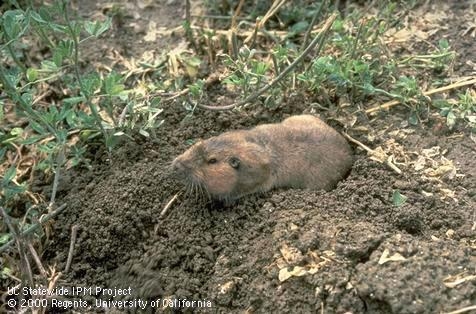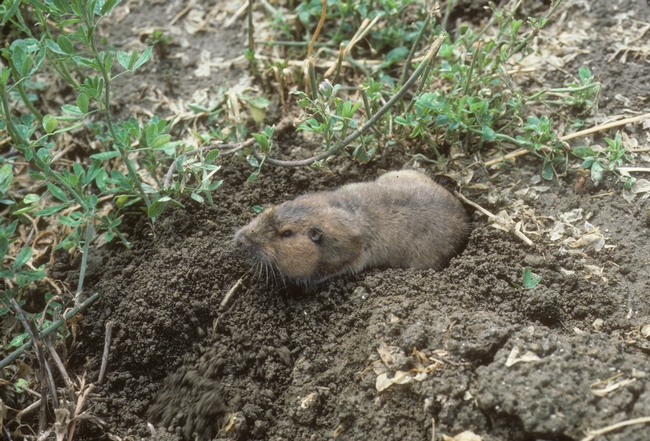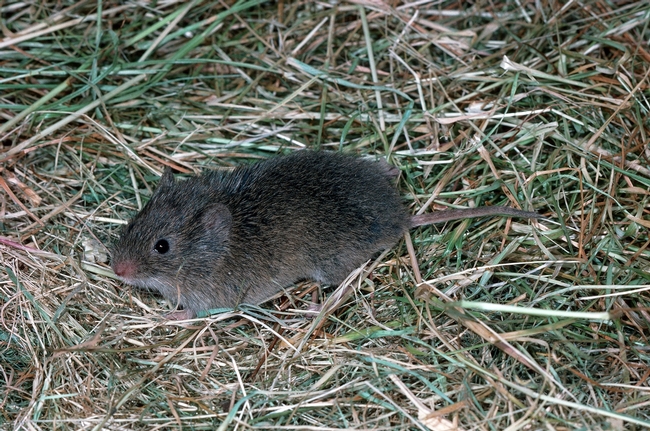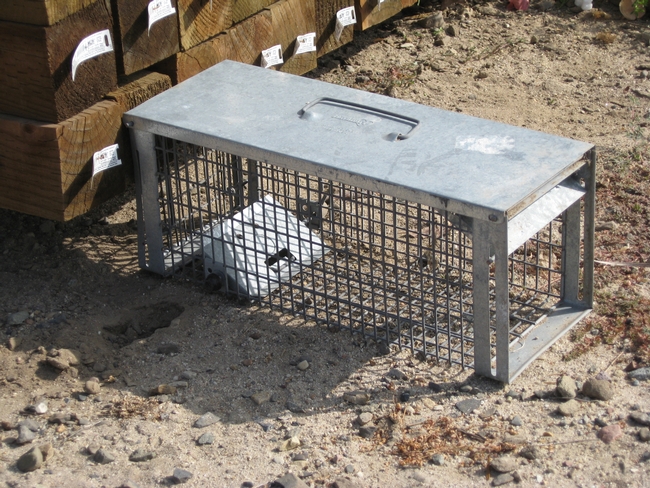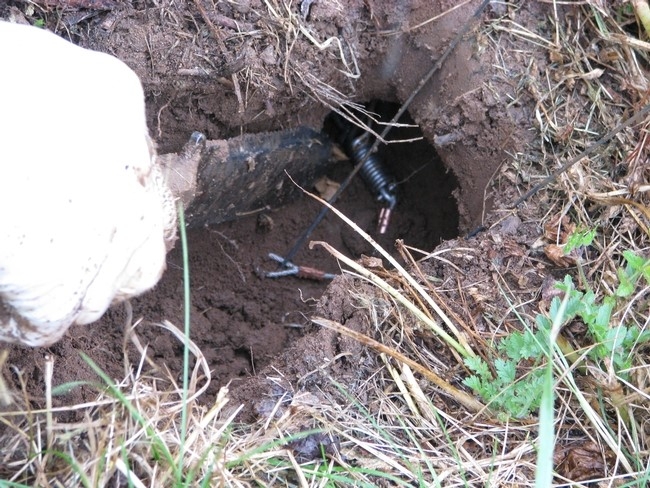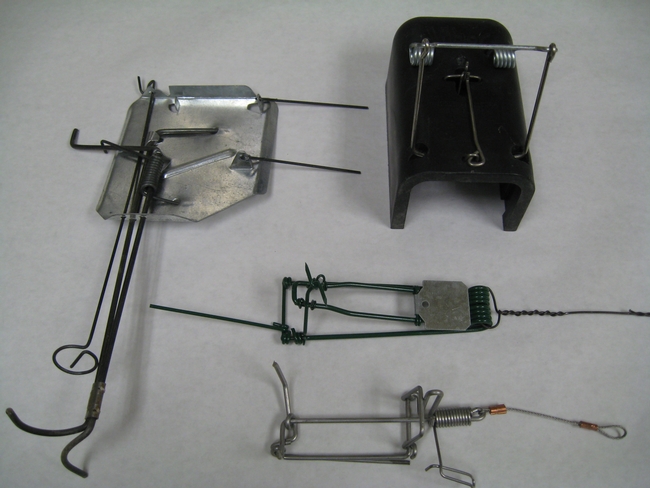
Posts Tagged: gophers
Organic Control of Rodents
Burrowing Rodents: Developing a
Management Plan
for Organic Agriculture in CA
RELATED ITEMS
- California ground squirrels Otospermophilus spp.
- Pocket Gophers Thomomys spp.
- Meadow voles Microtus spp.
This free publication is available by download.
This publication is best viewed using the free Adobe® Acrobat® Reader. You can download a free copy of the Acrobat Reader from Adobe Systems Incorporated.

ground squirrel
Burrowing Varmints Guide
- Author: Pamela Kan-Rice
Burrowing rodents can cause extensive and expensive damage to orchards and crop fields. To manage the pests without chemicals used on conventional farms, organic growers can consult a new publication from UC Agriculture and Natural Resources scientists.
“Burrowing Rodents: Developing a Management Plan for Organic Agriculture in California” outlines management within organically acceptable methods using an integrated pest management approach.
California ground squirrels, pocket gophers and meadow voles are the three most common species that cause damage. Squirrels chew on seedlings, fruit and nuts, killing young trees and reducing crop yields. In addition to plants, ground squirrels, pocket gophers and voles can chew on irrigation lines, and their burrow systems can channel water away from plants and erode the soil. The holes and mounds created by burrowing rodents pose hazards to farmworkers and farm machinery.
Meadow mouse or vole that can girdle a tree if you aren't watching
This publication helps growers identify the rodent species on their properties, their life cycles and tools available to control them.
“Growers can read about how to effectively select and set a range of traps for burrowing rodents,” said co-author Margaret Lloyd, UC Cooperative Extension small farms advisor for the Capitol Corridor. “Traps are an important tool for organic management, but maximizing control comes from integrating knowledge. Here we present information about rodent biology, trap efficacy, biocontrol, habitat management, plant protection and other approaches to collectively manage the pest problem.”
In the publication, Lloyd and Roger Baldwin, UC Cooperative Extension wildlife specialist in the UC Davis Department of Wildlife, Fish and Conservation Biology, review the effectiveness of commercially available traps – where to place the traps, whether to use attractants, and methods of euthanizing the animals.
They also offer cultural techniques for deterring rodents such as flooding fields and deep ripping soil to destroy burrow systems. Crops for orchard floors or cover cropping can be selected and managed to minimize habitat that protects and encourages gophers and voles.
For biological control, they suggest barn owls, raptors and snakes might be able to assist, but warn growers that predators alone will not be able to eat enough of the rodents to reduce the high populations to tolerable levels for many growers.
“Effective management will rely on a suite of tools,” said Baldwin.
The 15-page publication is available for free download at https://anrcatalog.ucanr.edu/Details.aspx?itemNo=8688.
It's Dry Root Rot Time
Even though it's been a mild winter; other than fire, rain and some cool nights, we did have a few days of hot weather, which is just what sets off citrus dry root rot. It pops up after the first hot weather of the spring, and there it was driving down the road. There's nothing that can be done with this tree. Tree removal and replacement is the answer. Prevention is the solution. We know that Fusarium fungus is usually associated with the collapse, but wounding is the key. Mechanical injury from weed whips, discs, gophers, voles, rabbits. Wounding from salt damage might do it too.
Dry root rot, a disease caused by the soil fungus Fusarium solani, has a long history of hindering production of citrus in California. Fusarium solani is a weak pathogen that infects only when there is some kind of stress in citrus tree. However, presence in almost all citrus orchards everywhere in the world including California, enhance its quick exploitation of such stresses. Some of the factors that are possible stress include invasion by other pathogens, such as Phytophthora and Citrus Tristeza Virus (CTV). Other stresses are wounding by gophers/rodents or insects, girdling, asphyxiation especially drowning the tree with too much water, soil nutrient content and fertilization, irrigation, and other cultural practices in the orchard. The pathogen is an opportunist on citrus. With the stress, Fusarium solani begins infection by colonizing the cortical tissue of feeder roots, advances into the lower tap root and/or scaffold root, and move up through the bud union into the center of the trunk. Studies over the years have shown that many rootstocks are susceptible and old trees as well as young twigs are not spared of the disease.
http://ipm.ucanr.edu/PMG/r107100211.html
//ucanr.edu/blogs/blogcore/postdetail.cfm?postnum=17821
Photo: collapsed tree near and older one on the right, but also near a younger one that probably was a replacement for one that had collapsed several years prior
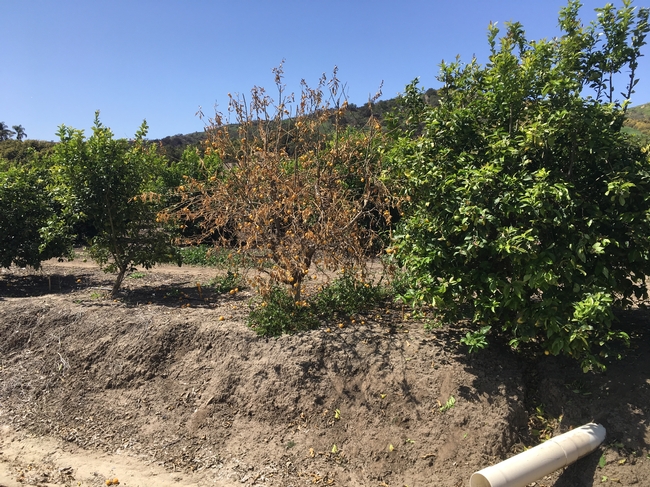
dry root rot time
An Ecology of Farming or Unintended Consequences
Problem: There was a Valencia farmer in Ojai, farming on a rocky loam. More rocky than loam, on a 10 % slope, where he had been spraying the weeds down, the soil had gradually washed away and all he had left was scattered cobbles.
Solution: He planted a winter cover crop to protect the soil from erosion. He weed whipped it three times a year because that's all he could afford.
Result: After two years he had stopped the erosion, and there was actually a little duff layer forming in the orchard from the decomposing ground cover.
Problem: But now that wonderful cover crop and the cover it provided had attracted gophers that were chewing on the trees and because of inattention had killed a few of them. He couldn't trap fast enough.
Solution: He brought in a ‘Jack Russell' terrier that did a marvelous job at keeping the beasts down.
Problem: About the same time he noticed that he was getting gobs of snails that were getting into the trees. Even though he had lifted the skirts and painted copper on the trunks, they were still getting into the trees. He couldn't keep up with the winter weeds.
Solution: He brought in weeder geese to help with the ground cover and chickens to help with the snails and they worked.
Problem: Now the terrier is distracted by the fowl and is killing the chicks and goslings, as well as the gophers. In fact, he would prefer chasing the fowlings to going after gophers.
Solution: He tied a tether ball around the terrier's neck which slowed it down enough so that the young ones could get away.
Problem: Also with the introduction of birds, he also brought in coyotes which killed the larger birds.
Solution: He brought in a ‘Queensland Heeler' which is a bred that is noted for killing dingos in Australia. They are short-legged, barrel chested dogs that roll over on their back and pretend to be dead and when the coyote comes sniffing around, it grabs the coyote's neck and kills it.
Problem: What's next in this cause and effect chain of events?
This is a true story, but in today's world because of Food Safety and Good Agricultural Practices Certification would not happen with all these animals in the orchard, but something like it happens every time we overturn the flow of events. This is not the only scenario that is played out in agriculture. But hey, that's what a good grower is doing, managing a somewhat chaotic chain of events.

cover crop citrus
Vertebrate Pests Causing Damage in Citrus
Vertebrate pests that have caused damage to citrus trees include rodents and small mammals, large mammals, and birds. Citrus orchards provide food and shelter for a number of these pests, and damage may be severe if the pest resides in the orchard. Damage can occur to the fruit such as rat chewing or bird droppings. Bark damage and tree death can occur from rodents and larger mammals. Damage to irrigation systems such as chewing on hoses can easily be the most expensive damage.
The goals of a successful management program include reducing the number of pest problems and using control methods that are affordable. There are four key points to establishing and maintaining a vertebrate pest management program. First, one must identify the specific damaging species. Second, review all the management control options. Third, one must take action quickly and early, and use the best option that is appropriate for the time of year and the orchard. Fourth, use a monitoring system to detect when re-infestation occurs and thus more controls are needed.
The first key point is identification and observation. Many of the agricultural commissioners’ offices in the counties can help with this problem. In addition, University of California Production Manuals such as almond and walnut have reference material on different pests. It is critical to identify the specific species or type of pest causing damage. You can use direct observations with some pests such as birds or squirrels that are active during the day. With pests that are active at night or tend to hide, one looks for tracks, burrows, or the type of feeding; or one can use traps. With rodents, one can use the size of the incisor marks on plants to help identify the pest. This is also useful on irrigation systems, where one can remove the damaged part and take it to an expert. Traps are also used where trails are established to capture and identify the pest. Pictures, especially close-ups are very useful and can be emailed or sent to experts on the Internet. If you also describe the adjacent habitat such as foothills, streams or rivers, etc., that information will help.
For some pests, there are many possible control options. It is very important to check with the agricultural commissioner’s office as animals vary by protected status and how the animal can be legally controlled. The pest’s life cycle will determine when and if a certain control method can be used. For example, ground squirrels can be controlled effectively with poisoned baits but not in early spring when the animal is feeding on green material. Gophers can be controlled all year with poisoned baits that are applied into the burrows, but are more active when the soil is moist. Habitat modification may be an economical option, as brush piles near an orchard will provide shelter for pests. Biological control such as attracting owls and hawks to an orchard can assist with control, but seldom keeps rodent levels below economic levels.
It is important to act quickly when a control measure is selected. Some vertebrate pests can increase in population quickly, and control is less expensive with lower numbers of pests. Some pests will reside in the orchard, and create a home there. It is much easier to control them when the pests live outside the orchard.
Finally, it is important to have a monitoring system in place after controlling a vertebrate pest so as to detect if the pest is re-entering the orchard. A good record system is important.
Many of the citrus orchards in the San Joaquin Valley (SJV) are located near the foothills on the eastern side. Some of the more common vertebrate pests include gophers, ground and tree squirrels, mice, rats, rabbit, coyote, feral (wild) hogs, and starlings. Rare tree damage has occurred from bear and beaver. There is more new acreage in the SJV planted in the middle of the valley. Those trees will be susceptible to the vertebrate pests already found nearby.
Rodents such as gophers and meadow mice (or voles) feed on plant roots, and can girdle and kill young citrus trees. Occasionally, gophers can kill mature trees, especially if the tree is weakened by other factors such as root rot. Many members of the rat family and deer mice will feed on citrus fruit. The effectiveness of control measures depends on identifying the specific rodent. The Eastern Fox Squirrel (EFS) is a tree squirrel found near big cities in the SJV and throughout the metropolitan areas of Southern California. It has moved to adjacent commercial citrus orchards and will feed on ripe fruit.
Coyotes, rabbits, and squirrels will damage irrigation hoses. By examining the damage, experts can identify the pest. The EFS has caused considerable damage to irrigation systems in some nut crop orchards in the Fresno area.
Larger mammals can be economic pests. Wild hogs will feed on fruit, damage bark, and create large holes or “wallows” on the orchard floor where it is moist. Occasionally, hogs will destroy irrigation hoses. Beavers have destroyed young citrus trees located near streams.
Bird problems have occurred mainly due to large flocks of starlings that nested in orchards at night. The damage resulted from the bird droppings on the fruit.
More information about vertebrate pests can be found here.
